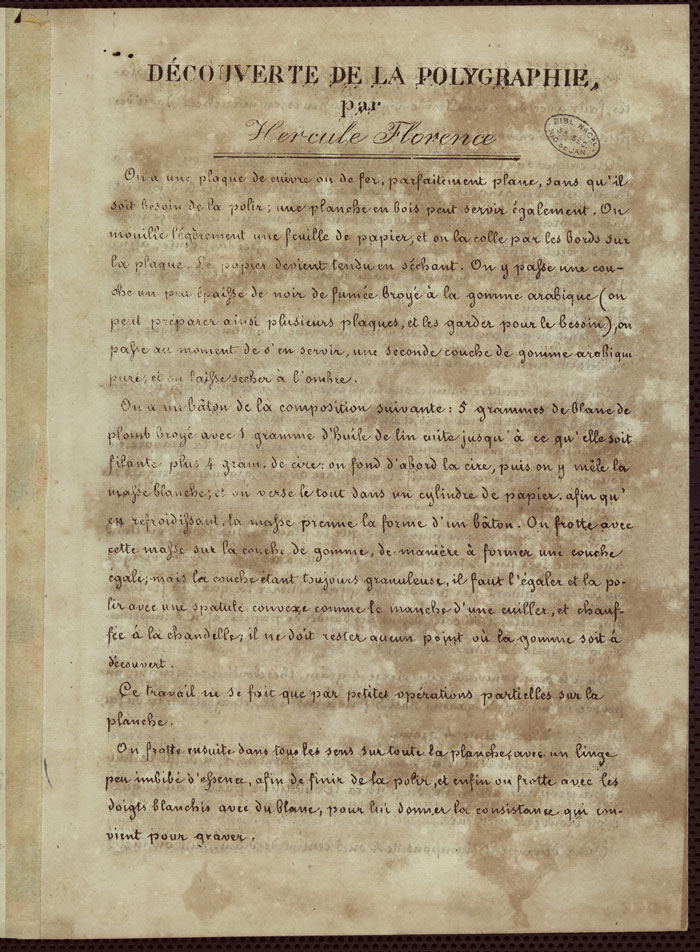hercule florenceinvents
poligraphy
Polygraphy (or Autography) was Hercule Florence’s first major print-related invention. The printing method was developed after experiencing some issues when printing his article on the “animal voices”, the Zoophony.
Hercule studied the scientific literature of the time on polyantography, engraving and lithography in the Archives des Découvertes et Inventions Nouvelles, which helped him develop polygraphy, a project to which he would devote himself for the remainder of his life.
Click to enlarge
![FLORENCE, Hercule, 1804-1879 [Copy of document produced on May 20, 1832, by Hercules Florence , in which he informs the City Council of São Carlos about the opening of an establishment at Rua do Rosário, house number 2, São Carlos (SP)] May 20, 1832. Xerographic copy on paper - 31.5 x 21.6 cm. Arnaldo Machado Florence Fund, Institute Hercule Florence Collection (São Paulo).](/images/inventos/poligrafia/m/AMF01.jpg) FLORENCE, Hercule, 1804-1879
FLORENCE, Hercule, 1804-1879[Copy of document produced on May 20, 1832, by Hercules Florence , in which he informs the City Council of São Carlos about the opening of an establishment at Rua do Rosário, house number 2, São Carlos (SP)] May 20, 1832. Xerographic copy on paper - 31.5 x 21.6 cm.
Arnaldo Machado Florence Fund, Institute Hercule Florence Collection (São Paulo).
[Copy of document produced on May 20, 1832, by Hercules Florence , in which he informs the City Council of São Carlos about the opening of an establishment at Rua do Rosário, house number 2, São Carlos (SP)] May 20, 1832. Xerographic copy on paper - 31.5 x 21.6 cm.
Arnaldo Machado Florence Fund, Institute Hercule Florence Collection (São Paulo).
![Title sheet of the publication “Invenção da Polygraphia por Hercule Florence” [Invention of Polygraphy by Hercule Florence] (Santos: Typographia Commercial de G. Delius, 1858).](/images/inventos/poligrafia/m/HF_Invencao-da-polygraphia_capa.jpg) Title sheet of the publication “Invenção da Polygraphia por Hercule Florence” [Invention of Polygraphy by Hercule Florence] (Santos: Typographia Commercial de G. Delius, 1858).
Title sheet of the publication “Invenção da Polygraphia por Hercule Florence” [Invention of Polygraphy by Hercule Florence] (Santos: Typographia Commercial de G. Delius, 1858).
 FLORENCE, Hercule, 1804-1879
FLORENCE, Hercule, 1804-1879Découverte de la Polygraphie, par Hercule Florence (Frontispício), 1853.
Polygraphy on paper - 15,1 x 20,2 cm.
Fundação Biblioteca Nacional Collection (Rio de Janeiro).
Découverte de la Polygraphie, par Hercule Florence (Frontispício), 1853.
Polygraphy on paper - 15,1 x 20,2 cm.
Fundação Biblioteca Nacional Collection (Rio de Janeiro).
![FLORENCE, Hercule, 1804-1879 [Verso of page 110 of the manuscript “Livre d’annotations et de premiers matériaux”], 1829-1836. Ferrogallic ink on paper – 21.8 x 16.2 cm. Institute Hercule Florence Collection (São Paulo). Photo: Heitor Florence.](/images/inventos/poligrafia/m/Diario-I-110v.jpg) FLORENCE, Hercule, 1804-1879
FLORENCE, Hercule, 1804-1879 [Verso of page 110 of the manuscript “Livre d’annotations et de premiers matériaux”], 1829-1836.
Ferrogallic ink on paper – 21.8 x 16.2 cm. Institute Hercule Florence Collection (São Paulo). Photo: Heitor Florence.
[Verso of page 110 of the manuscript “Livre d’annotations et de premiers matériaux”], 1829-1836.
Ferrogallic ink on paper – 21.8 x 16.2 cm. Institute Hercule Florence Collection (São Paulo). Photo: Heitor Florence.
![FLORENCE, Hercule, 1804-1879 [Verso of page 116 of the manuscript Livre d’annotations et de premiers matériaux], 1829-1836. Ferrogallic ink on paper – 21.8 x 16.2 cm. Institute Hercule Florence Collection (São Paulo). Photo: Heitor Florence.](/images/inventos/poligrafia/m/Diario-I-116v.jpg) FLORENCE, Hercule, 1804-1879
FLORENCE, Hercule, 1804-1879 [Verso of page 116 of the manuscript Livre d’annotations et de premiers matériaux], 1829-1836.
Ferrogallic ink on paper – 21.8 x 16.2 cm. Institute Hercule Florence Collection (São Paulo).
Photo: Heitor Florence.
[Verso of page 116 of the manuscript Livre d’annotations et de premiers matériaux], 1829-1836.
Ferrogallic ink on paper – 21.8 x 16.2 cm. Institute Hercule Florence Collection (São Paulo).
Photo: Heitor Florence.
![Page 12 of the manuscript “L’Ami des arts livré à lui-même ou Recherches et découvertes Sur différents sujets nouveaux Par Hercule Florence”], 1837-1859. Ferrogallic ink on paper – 30.6 x 21.0 cm. Institute Hercule Florence Collection (São Paulo). Photo: Heitor Florence.](/images/inventos/poligrafia/m/L-Amie-des-Arts_pag-12.jpg) Page 12 of the manuscript “L’Ami des arts livré à lui-même ou Recherches et découvertes Sur différents sujets nouveaux Par Hercule Florence”], 1837-1859. Ferrogallic ink on paper – 30.6 x 21.0 cm. Institute Hercule Florence Collection (São Paulo).
Page 12 of the manuscript “L’Ami des arts livré à lui-même ou Recherches et découvertes Sur différents sujets nouveaux Par Hercule Florence”], 1837-1859. Ferrogallic ink on paper – 30.6 x 21.0 cm. Institute Hercule Florence Collection (São Paulo).Photo: Heitor Florence.
Photo: Heitor Florence.
In contrast to the time-consuming and expensive methods of letterpress and lithography, in 1831 Florence proposed using a wax plate as a matrix, and an ink of a denser consistency. This allowed him to print without the need for a large, heavy press.
After some years of experiments – which he conducted alongside his research on Photography – Hercule Florence succeeded in making polygraphy print all colors simultaneously, which represented a significant technical advancement over traditional engraving. Later, in 1838, as a result of this technique, he created the Inimitable Paper. Although used for small-scale commercial printing (pharmacy labels, advertisements), the method was never promoted or sold.
RECOMMENDED LITERATURE:
- FLORENCE, Hercule. Livre d'annotation et de premiers matériaux, 1829-1836. Manuscrito, Tinta ferrogálica sobre papel, 22,5 x 17,5 x 3,3 cm. Coleção Instituto Hercule Florence (São Paulo)
- FLORENCE, Hercule. L'Ami des arts livré à lui-même ou Recherches et découvertes Sur différents sujets nouveaux Par Hercule Florence, 1837-1859. Manuscrito, Tinta ferrogálica sobre papel, 30,6 x 21,0 cm. Coleção Instituto Hercule Florence (São Paulo)
- FLORENCE, Hercule. Découverte de la Polygraphie, par Hercule Florence, 1853. Manuscrito, Tinta ferrogálica sobre papel. Coleção Fundação Biblioteca Nacional (Rio de Janeiro)
- FLORENCE, Hercule. Invenção da Polygraphia por... Santos: Typographia Commercial de G. Delius, 1858.
- KOSSOY, Boris. Hercule Florence: a descoberta isolada da fotografia no Brasil. 3ª edição revista e ampliada. [São Paulo]: EDUSP, [2006].
- BOURROUL, Estevam Leão. Hercules Florence (1804-1879): ensaio historico-litterario por... São Paulo: Typographia Andrade, Mello & Comp., 1900.
- Hercule Florence e o Brasil: o percurso de um artista-inventor. [São Paulo]: Pinacoteca do Estado, [2009]. (catálogo de exposição)
